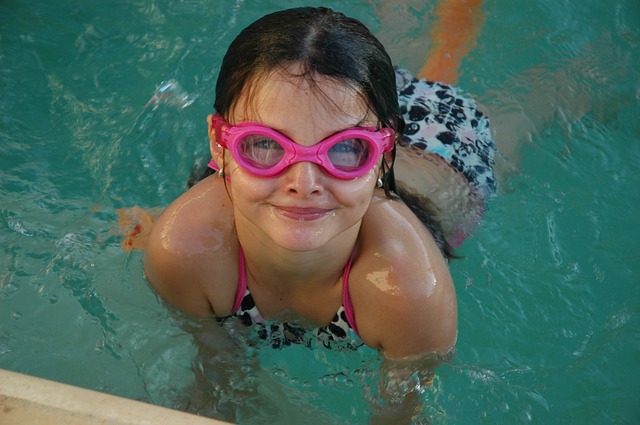Summertime means days outside in the sun, playing sports, spending time with friends, and splashing in the pool or one of Coppell Texas’ beautiful waterways. Swimming is excellent for early childhood development, as it builds fitness, skills, and friendships. It’s also incredibly important to establish safe water practices in kids at a young age, so that they know how to protect themselves and look out for others. Even toddlers should be taught water safety. Luckily, there is plenty of good advice on this subject as well as spots to take your kids for swimming classes.
At Crème de la Crème in Coppell, Texas, we have a splash pad and water park and understand the importance of early childhood swimming and water safety. That’s why we emphasize supervision for younger children in particular, and encourage learning safe water practices early on. We hope this article helps you prepare for the summer and enjoy safe days at the pool!
Water Safety 101

“Swimming Girl Goggles” used with permission via Pixabay by ArtWithTammy
As parents, some of the top safety tips include supervising your kids while they swim, knowing CPR and first aid, and enrolling your children in swimming classes. It’s your responsibility to keep your kids safe while also teaching them to make good decisions around pools so they can also look out for themselves.
If you’re at a public pool, lake, ocean, or just hosting the kids at your backyard pool, there should always be at least one adult that’s acting as the lifeguard. This person shouldn’t have any distractions (such as books or phones) while they are in charge. It’s essential that they’re super vigilant, especially as water games can get rowdy and tiring.
Establish ground rules for swimming, including no pushing, running, or shoving. If you’re in a larger water body such as a lake or ocean, enforce life jacket wearing. It’s also best that the adults participate to teach good practices going forward.
Encourage kids to take a break regularly to allow them to relax, drop their heart rate, and catch their breath. Designate swimming times and restrict access otherwise. Having barriers to the pool, such as pool fencing, can limit younger kids’ access when supervision isn’t readily available. It’s also important to have rescue devices nearby in case a child slips beneath the water unexpectedly.
It’s also important to establish safe water entry and exit techniques. Designate a spot in the pool, ideally where you have stairs or a ladder, that children should use to enter and exit the water. This helps the adults supervising as well, by limiting points of access for young children. Have them walk into the pool slowly, rather than running or jumping.
Infant Swimming
Children under the age of four are the most susceptible to drowning, and therefore require the most supervision and assistance. That’s why infant rescue swimming is so valuable to teach skills early on that can form the building blocks for progressively safe behavior.
Even babies that aren’t old enough to walk can swim, and this can be useful in developing and improving cognitive function. Teaching swimming early can reduce the risk of drowning in children over the age of four, according to studies. It also builds self-confidence, self-control, and self-esteem. Swimming with your infant is also an excellent way to increase bonding time. It also helps with coordination and muscle development, as well as enhancing cardiovascular health.
Different Types of Floatation Devices
There are many different kinds of floatation devices that can contribute to safe and fun swimming practice. The best kinds of floaties will allow your child to learn swimming techniques while also being comfortable and non-restrictive.
Traditional kids’ floaties include armbands, and some of the best today have armbands that are attached to body life vests for extra buoyancy. Adjustable straps and quick-release buckles are added features you should look for. The Puddle Jumper brand offers a combination armband and life jacket product that is U.S. Coast Guard approved for boat passengers.
Backpack floatation devices strap around your child’s chest and help them when learning swim strokes. This is ideal for children up to 55 pounds. If your child is a bit older and wants more mobility and freedom, a kickboard or boogie board is a great option. Or, for younger children that simply want to float along while sitting upright, consider one of the larger inflatable floaties that allows the child’s legs to dangle down in the water while supporting their back.
Swimming Classes in and Around Coppell
There are a few places to take your kids for swim classes in Coppell. Aqua-Tots Swim Schools offers lessons year-round for children of every age, beginning at four months old. Each instructor has received over 40 hours of training and is CPR certified. At Aqua-Tots, children advance through levels of learning, adding new skills and swim techniques along the way.
Coppell Swim School offers swim lessons in a private pool, with group and private lessons available. They also offer children’s aquatics to introduce younger kids to pool safety and introductory aquatic techniques. Participants can then advance to more experienced courses, including stroke improvement and diving.
The Coppell City Parks and Recreation department offers aquatics at its location on Parkway Boulevard. They have both indoor and outdoor pools available. Coppell residents get free access to their “Learn to Swim” program, for preschool and beginner swimmers. Classes fill up quickly, and registration is required. They also offer virtual swim lessons, for those who want to teach safe swimming practices from the comfort of their home pool. Classes include preschool and beginner levels.
We hope this article has inspired you to grab some floaties and friends and head to the pool for safe and supervised swimming. At Crème de la Crème, we emphasize hands-on learning through experience, and we believe swimming should be just the same. If we missed your favorite safe swimming rule, let us know.
